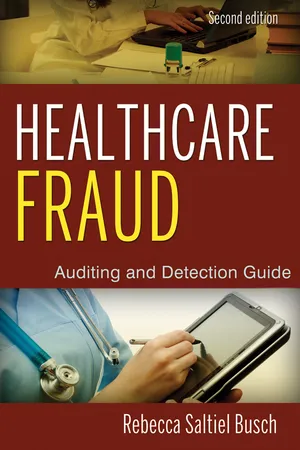
- English
- ePUB (mobile friendly)
- Available on iOS & Android
About this book
An invaluable tool equipping healthcare professionals, auditors, and investigators to detect every kind of healthcare fraud
According to private and public estimates, billions of dollars are lost per hour to healthcare waste, fraud, and abuse. A must-have reference for auditors, fraud investigators, and healthcare managers, Healthcare Fraud, Second Edition provides tips and techniques to help you spot—and prevent—the "red flags" of fraudulent activity within your organization. Eminently readable, it is your "go-to" resource, equipping you with the necessary skills to look for and deal with potential fraudulent situations.
- Includes new chapters on primary healthcare, secondary healthcare, information/data management and privacy, damages/risk management, and transparency
- Offers comprehensive guidance on auditing and fraud detection for healthcare providers and company healthcare plans
- Examines the necessary background that internal auditors should have when auditing healthcare activities
Managing the risks in healthcare fraud requires an understanding of how the healthcare system works and where the key risk areas are. With health records now all being converted to electronic form, the key risk areas and audit process are changing. Read Healthcare Fraud, Second Edition and get the valuable guidance you need to help combat this critical problem.
Frequently asked questions
- Essential is ideal for learners and professionals who enjoy exploring a wide range of subjects. Access the Essential Library with 800,000+ trusted titles and best-sellers across business, personal growth, and the humanities. Includes unlimited reading time and Standard Read Aloud voice.
- Complete: Perfect for advanced learners and researchers needing full, unrestricted access. Unlock 1.4M+ books across hundreds of subjects, including academic and specialized titles. The Complete Plan also includes advanced features like Premium Read Aloud and Research Assistant.
Please note we cannot support devices running on iOS 13 and Android 7 or earlier. Learn more about using the app.
Information
- $108 billion (16 percent) of the above is paid improperly due to billing errors. (Centers for Medicare and Medicaid Services, www.cms.gov)
- $33 billion Medicare dollars (7 percent) are illegitimate claims billed to the government. (National Center for Policy Analysis, www.ncpa.org)
- $100 billion private-pay dollars (20 percent) are estimated to be paid improperly. (www.mbaaudit.com)
- $68 billion in health insurance fraud (3 percent of expenditures). (www.insurancefraud.org)
- $50 billion (10 percent) of private-payer claims are paid out fraudulently. (BlueCross BlueShield, www.bcbs.com)
- $37.6 billion is spent annually for medical errors. (Agency for Healthcare Research and Quality, www.ahrq.gov)
- 10 percent of drugs sold worldwide are counterfeit (up to 50 percent in some countries) (www.fda.gov). The prescription drug market is $121.8 billion annually (www.cms.gov), making the annual counterfeit price tag approximately $12.2 billion.
- Misrepresentation of a material fact
- Knowledge of the falsity of the misrepresentation or ignorance of its truth
- Intent
- A victim acting on the misrepresentation
- Damage to the victim
- Incidents or practices that are not consistent with the standard of care (substandard care)
- Unnecessary costs to a program, caused either directly or indirectly
- Improper payment or payment for services that fail to meet professional standards
- Medically unnecessary services
- Substandard quality of care (e.g., in nursing homes)
- Failure to meet coverage requirements
- False statements or claims
- Elaborate schemes
- Cover-up strategies
- Misrepresentations of value
- Misrepresentations of service
Table of contents
- Cover
- Title Page
- Copyright
- Dedication
- Preface
- Acknowledgments
- Chapter 1: Introduction to Healthcare Fraud
- Chapter 2: Defining Market Players within the Primary Healthcare Continuum
- Chapter 3: Continuum Audit and Investigative Model
- Chapter 4: Secondary Healthcare Continuum
- Chapter 5: Information Healthcare Continuum
- Chapter 6: Consequence Healthcare Continuum
- Chapter 7: Transparency Healthcare Continuum
- Chapter 8: Rules Based Healthcare Continuum
- Chapter 9: Protected Health Information
- Chapter 10: Health Information Pipelines
- Chapter 11: Accounts Receivable Pipelines
- Chapter 12: Operational Flow Activity
- Chapter 13: Product, Service, and Consumer Market Activity
- Chapter 14: Data Management
- Chapter 15: Normal Infrastructure
- Chapter 16: Normal Infrastructure and Anomaly Tracking Systems
- Chapter 17: Components of the Data Mapping Process
- Chapter 18: Components of the Data Mining Process
- Chapter 19: Components of the Data Mapping and Data Mining Process
- Chapter 20: Data Analysis Models
- Chapter 21: Clinical Content Data Analysis
- Chapter 22: Profilers
- Chapter 23: Market Implications
- Chapter 24: Conclusions
- About the Author
- Index